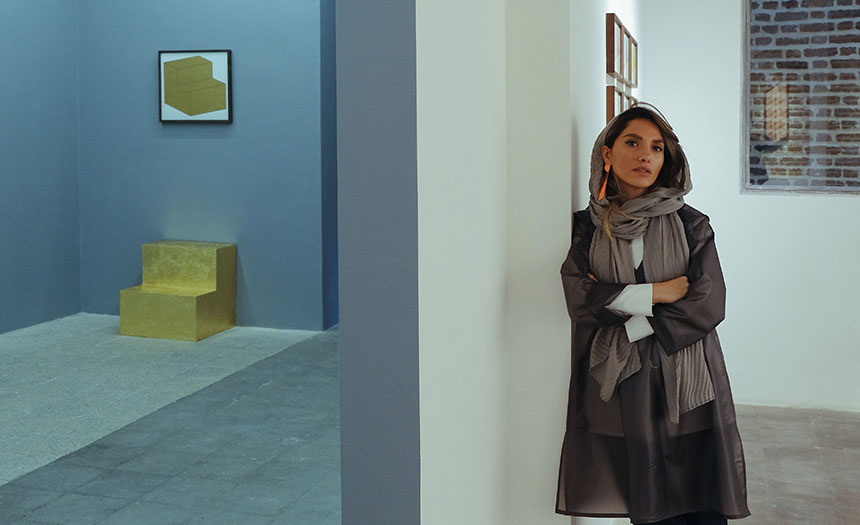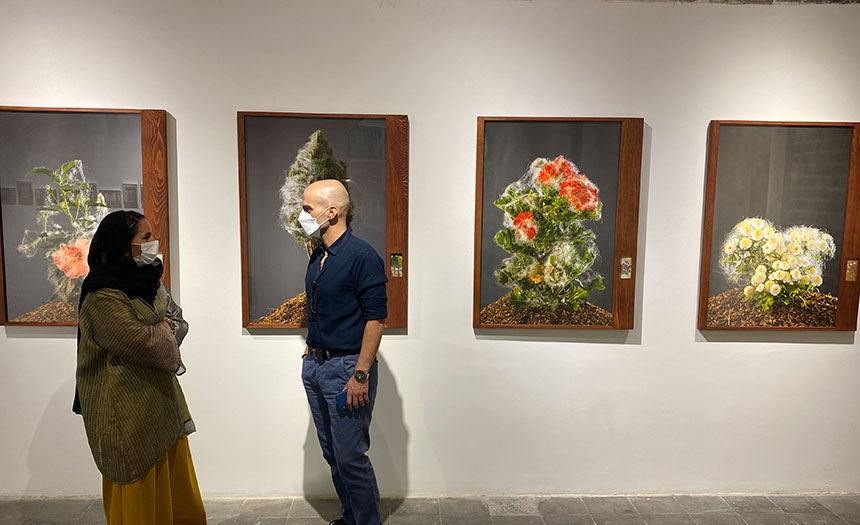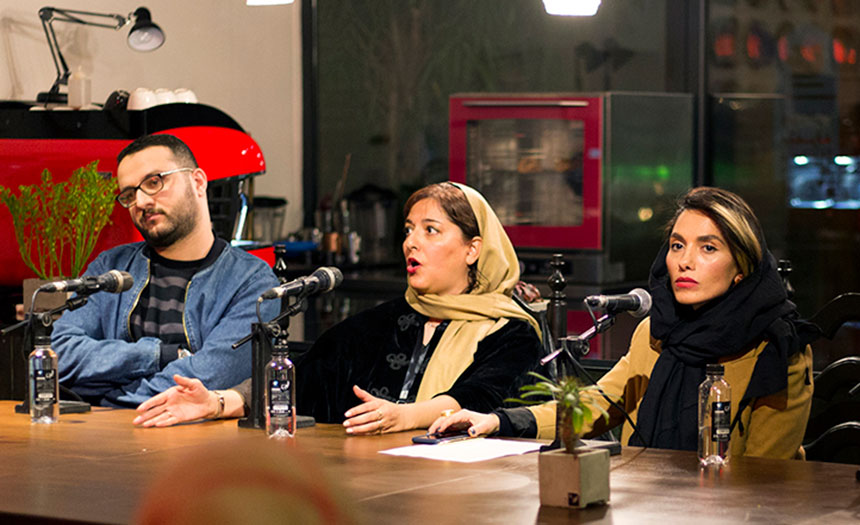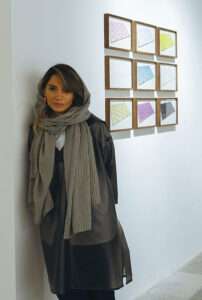By: Ghazal Mostafa
 Born in 1985, Shahed Saffari is the director of INJA gallery and gallery liaison at Teer Art INJA Gallery was founded by Saber Abar in the autumn of 2018, and Teer Art, where Shahed joined also in 2018 and is charged with forming and maintaining relationships with other galleries as local brand ambassador, is a private-sector initiative to promote modern and contemporary Iranian art through two simultaneous and sister events: Teer Art Fair and Teer Art Week. Teer Art aims to create a space connecting local and international galleries, art collectors, industry professionals and visitors of all backgrounds and stripes. From emerging artists to established modern masters, from urban installations to panel talks, Teer Art offers a complete insight into the exciting and fast-moving world of contemporary Iranian art.
Born in 1985, Shahed Saffari is the director of INJA gallery and gallery liaison at Teer Art INJA Gallery was founded by Saber Abar in the autumn of 2018, and Teer Art, where Shahed joined also in 2018 and is charged with forming and maintaining relationships with other galleries as local brand ambassador, is a private-sector initiative to promote modern and contemporary Iranian art through two simultaneous and sister events: Teer Art Fair and Teer Art Week. Teer Art aims to create a space connecting local and international galleries, art collectors, industry professionals and visitors of all backgrounds and stripes. From emerging artists to established modern masters, from urban installations to panel talks, Teer Art offers a complete insight into the exciting and fast-moving world of contemporary Iranian art.
With six years’ experience managing and assisting a photography gallery, Shahed is closely connected to both Tehran galleries and the national artistic community. Shahed is also a board member of Iran Galleries Association since September 2021.
Please tell us about yourself and your background. How did you get involved in INJA Gallery? What about Teer Art?
I am Shahed Saffari. I have been working professionally in the art world for about 10 years. Academically, I became familiar with art when I started studying graphic art at school. Later in 2003, I studied painting at the University of Science and Culture in Tehran. I entered the world of art galleries when I began working at Silk Road Gallery (2012), which specializes in photography. During the five years I worked there, I met photographers, artists, gallery owners and collectors who laid the foundation for the network I have now. The experience of participating in art fairs and photography festivals alongside the Silk Road Gallery director, Ms. Anahita Ghabaian was very attractive to me. After a while, I decided to work independently and to expand my network. This required me to step out of my comfort zone, which felt risky at the time.
But within a year I was collaborating with both Teer Art and INJA Gallery!
Tell us about a typical day at work. How does it start? What do you do? What motivates you at the workplace? What have you learned from mistakes on the job?
My workday does not have a specific time span. For example, I can be sitting at my laptop and working at 3 a.m. A lot of my work is done on the laptop, my notebook and the online calendar for gallery planning. So, I can work wherever and whenever I’m focused. Sometimes, I work in the gallery office outside of the work hours and before my colleagues arrive. The rest of my daily workday is devoted to appointments. And recently, because I’m a member of the board of Iran Gallery Association, its work has also been added to my agenda. Visiting artists’ studios is a constant part of my schedule.
One of the things I always try to pay attention to in my work is the saying “Don’t put off until tomorrow what you can do today”. I try doing everything on time as much as possible, because accumulating them together can disrupt my schedule altogether and deprive me of peace of mind necessary for me to accomplish my daily goals. Something one of the successful managers, Mr. Shahin Fatemi, has once said is always on my mind: “Always start by doing things that are hard to do for you and you’re running away from.” This phrase gives you a strange energy to move forward. Sometimes when I have a job-related problem, it’s when I check and see that things have piled up and so it’s just not going well. So recently, my new routine includes simply taking some time off during the week to come back to my work with a fresh outlook.
Describe your creative process for curating exhibitions, from conception to execution.
With respect to the fundamental premise of our exhibits and the process of selecting the artworks, we have determined an ethos and fundamental mindset for our gallery by which we choose the path of the shows.
We have a combination of both in the exhibitions we hold at the gallery, that is, a number of group exhibitions and a certain number of solo exhibitions are held throughout the year, for all of which we have tried to have a specific process because it allows us to move forward more focused on this path.
In defining this line of thought, we usually move group exhibitions forward by topic. This way, we choose a topic and accordingly, different generations, both modern and contemporary, with younger and older artists coming together. Combining these two generations makes the result fascinating.

There are times when we find a collection by chance, or maybe it gets emailed to us. Sometimes artworks that are sent for our review don’t fit in our line of thought, but we decide to take them on it because we see that they have something new to say. These out-of-line collections can sometimes make the audience think and be a stimulus for drawing them to the exhibition. In the last three years since we started our work, we’ve always considered this point in the exhibitions we’ve held.
When we enter the execution process, we first determine the date of the exhibition with the artist, and after this step, we go through a series of routine procedures that are necessary for the setting up of any exhibition. These procedures include creating the content of the exhibition advertisements, setting the price list of the works, and preparing the list of invitees of the exhibition which are all done with the help of our colleagues in the gallery. The invitations to an exhibition are usually divided into several categories as some are sent to the gallery’s mailing list, some are sent to serious art connoisseurs, and then of course we have the general public, and also a group of art students interested in artworks. Finally, a series of processes are conducted for preparing the physical space of the exhibition and deciding the form of installation of the works.
We have a tradition at the INJA Gallery that we paint one of the two halls that make up the exhibition space based on the artworks being shown and in consultation with the artist. This painting of the walls is done ahead of the final installation phase in the week before opening of an exhibition.
How do current trends in the artistic community influence your work? How do you find new artists, new ideas? How should an artist contact or approach a curator or a gallery?
The art community in Iran is small, and those who are active in it are in some form of relationship, either direct or indirect. And because of these connections, they are all relatively familiar with each other. People like gallery owners, curators, art teachers or those who personally have art schools, and artists and anyone who is working in this field in one way or another, have their own lines of thoughts and individual behavior towards the concept of art gallery. And each one of these people’s individual behavior in their own position can create a new wave or a new path in the world of art exhibitions and have an impact of his or her own. This personal attitude toward art and how it should be exhibited can sometimes have positive or negative effects on the process of curating artwork. Historically we’ve seen that the personal attitudes of some of these artist “influencers” have been interpreted in different ways by people. This is a very important topic around the world, and it is often the topic of discussion by art panels where it is debated on several levels. There are also many books that have been written on these different viewpoints with translations available in the Iranian market for those interested.
As a result, if a trend is started by someone in a specific field of art, it will certainly affect the behavior and activities of all involved. This fact is especially important in Iran since we live in an Islamic society with its own rules. So, gallery owners, for instance, must pay special attention to these trends and consider them carefully. A misjudgment of the meaning and charge of a trend can have consequential effects on the license of a gallery owner who is obligated to work within the framework of existing rules of the country.

On the subject of finding new ideas and artists, the process is such that Saber and I supervise the gallery’s exhibitions together. Obviously because I manage the internal affairs of the gallery personally, I’m more directly involved in the day-to-day affairs. But when it comes to choosing exhibition contents and artists, both of us are equally decision-makers. One thing that’s interesting in our collaboration is that apart from the friendship that has been between us for years, sometimes our tastes are not the same, but we always try not to impose our personal opinion and tend to approach the subject with the goal we’ve chosen for the gallery and decide accordingly.
I check the emails for artists who send us their work, and if I see anything significant, I send it to Saber and we talk about it. On average, a very small percentage of the work that is emailed to the gallery is of acceptable quality or is sent according to the correct guidelines. There have been several cases where a work has attracted our attention from the emails, or we see and select something from the artist’s Instagram. We then send a message to the artist and if they’re not working elsewhere, we meet with them to check their work closely. Sometimes artworks don’t have the necessary quality up close, and many times it may be the opposite and we find impressive pieces.
As for ideas, I think that when you start a job and you move forward with it, new ideas find their way. This is especially true if quality is important to you, and you are serious in your work and your convictions. Having said that, one can still innovate and be creative in unpredictable conditions too if necessary. Galleries are rated for their quality of exhibitions and the artwork they choose to display and that is where we see how much a gallery has considered the creativity that we talked about earlier. This creativity for a gallery can be anything, like a series of out-of-gallery exhibitions or shows held in public spaces, or a series of projects at artists’ studios, and many other ventures that are based on the initial line of thought. Saber and I also talk about these subjects, although we each also think about them separately. I get involved in daily affairs of the gallery sometimes and so Saber has greater opportunity to think more deeply about gallery themes and topics and so he comes up with very good and interesting ideas. We then talk about how much potential an idea has to be carried out.
About how artists present their work to the gallery, I personally have held workshops on this subject and have tried to talk about it in different media. Presenting the works has a hierarchy and it’s important that artists pay attention to it. I’ve talked about it on an Instagram live on the Academy page and tried to briefly explain it.
It was early in the pandemic that INJA Academy held a number of online workshops, one of which was about the relationship between the artist and the gallery, and in one section there is mention of how the artist should promote him- or herself for the gallery. It is rare for prestigious young artists who are working professionally to interact with galleries themselves directly. There has always been a divide between the artist and galleries, which I think is the result of a tradition shaped over time that made galleries out of reach to artists. In other words, there have always been gallery owners who give their artists enough time to align themselves with the expected quality of the gallery and exhibitions, but unfortunately there are times when this alignment doesn’t happen. This created a friction and a divide between the artist and the gallery owners which had become hard to bridge. Today, of course, the relationship and the quality of interaction between these two parties are much improved.
Of all the proposal emails we receive, some are not interesting in terms of their presentation. But even so, I always take the time to check each and every one of our emails regularly. Sometimes I get an email with high quality artwork but it comes to us with an inferior quality presentation, or else it’s been sent in a very disorderly fashion. Unfortunately, the reason might be because the artist was never trained in proper presentation and delivery of their work.
I often see an artist who has an academic education but lacks this very essential skill to best showcase his or her work because this is not something that can be taught at the university. Being able to promote oneself is very necessary for an artist as it provides a chance for their work to be exhibited in a deserving way at some point, get commented on, and be guided toward its natural growth path. If an artist doesn’t get to exhibit their work and their artwork is limited to their personal atelier, their story isn’t told, which can
be very sad especially for artists who have something new to say to their audience at large.
For you, what is the toughest or most challenging aspect of being an art gallery director? What is your perception of taking on risk? Describe one of the most challenging projects you’ve ever worked on. How do you handle stressful situations?
The biggest challenge of my job as a gallery director is to keep the gallery as a whole under control so every aspect of it runs seamlessly and in tandem.
Perhaps if I give you more detail about some aspects of my work you can get an idea. For one, the main object of my work every day is how to make the gallery better and more successful. We also have a number of artists who collaborate with us on a regular basis, and in order to continue this relationship, a separate project must be defined for each of them. I then must keep in touch with them frequently and discuss any new ideas they may have. So, as you can imagine, another challenging part of this job is upkeep of the relationship with the artists. Of course, if there is mutual understanding among all parties, this cooperation will go well.
Another challenge of a very different kind is the matter of gallery sales. A gallery is a business where you introduce artists and promote their artwork. As a gallery director I have to work on selling an artist’s artworks for whom their art is their main source of income, for a good price to benefit both the artist and the business that relies on a portion of the sales for its existence. To be successful in achieving the sales goals, I must keep adding to the number of gallery customers while maintaining a good relationship with them by updating them on a range of subjects from new artists and exhibitions our gallery is planning on having to answering any questions they may have about the art market in general. Costumer service is very important for both artists and clients, as well as anyone who is working with us.
In other words, if I can take care of art needs and provide our clients with proper service, that means I can keep doing business with them.
Risk taking is a part of our job, although I am not a person who can take a 100% risk. I have a rather strong conservative personality, but it is a fact that if you are reluctant to take any risks, you cannot grow or improve. So, in many places you have to come out of your safety zone and move forward.
These days our art gallery is in the process of participating in a foreign art fair for the first time, and so everything feels very different. In fact, we are entering another dimension in our work and each stage of this story is very challenging and at the same time very interesting to me.

How has the Covid-19 pandemic impacted your work and the art galleries’ activities? What is your thought on online exhibitions taking place during the outbreak of the pandemic, especially for important art fairs such as Teer Art?
When the pandemic started, it was a difficult situation and the entire world got impacted and it affected most jobs and professions in one way or another. Many galleries were closed for instance. We had to close INJA Gallery temporarily hoping that soon we would be together again. We were hoping for it to take only a month or so, but it dragged on much longer of course. So we quickly switched to the online exhibition format. The art gallery system is such that artists could also have online exhibitions, but it wasn’t a very satisfying experience for the artists personally, because every artist works very hard to put together a collection and wants to have a grand opening. Artists of all backgrounds want to have friends and potential buyers to come and see and enjoy their artwork in person, and this wasn’t a possibility.
That being said, we couldn’t just put a stop to everything, so we kept going. We held online exhibitions and took advantage of this period when galleries were closed to move INJA Gallery to its new home. So for about 3 months while we were preparing the new place, we didn’t have an exhibition. We tried to sell our artists work online and so we held a group exhibition that had a decent number of sales.
By the beginning of summer, we opened the gallery in its new location and had a very magnificent grand opening within the framework of all the Covid-19 protocols. The gallery has been open permanently ever since and the exhibitions are held regularly. If the gallery gets overly crowded, our colleagues at the gallery will guide visitors in and out to keep the number of visitors inside at the required maximum number for our space.
During these past two years, we were constantly in a situation that we had to make decisions quickly and instantaneously. In our decisions, we were required to consider all aspects of our work such as the artists, the gallery, morale of everyone involved and our social responsibility, and I think under these circumstances we all became very good gallery owners.
There are pros about online exhibition and of course some cons. For our online shows, we tried to provide the chance for the buyer to come and see the work in person in a private appointment to make the purchase.
During these unusual times, we haven’t had a moment of quiet. I believe you can be creative in any situation, but it’s in these extraordinary circumstances that you can succeed only with a little creativity. For us, we had to quickly change direction when something didn’t work anymore, and we always tried to find new solutions for any problems we encountered.
On the positive side, these conditions made it easier to cultivate an international audience. Last year we at Teer Art, had an online art fair and it had an amazing impact which might have even been more than in-person art fairs. We had visitors who couldn’t attend in-person and being online allowed them to see the artwork all the way from London, New York and many other places around the world which resulted in having good overall sales. While we have lots of obstacles, we did our best to be a successful and active team.
To give you a little background about Teer Art, we prepared and planned Teer Art Edition 3 before the pandemic, and when the lockdowns started, we kept everything on hold with the hope that things would get back to normal, but they didn’t. We had to completely postpone the show until things got better. The success of an art fair depends on the number of visitors who attend it and their physical presence.
Today with more people vaccinated and the pandemic somewhat tamed in most parts of the world, Art fairs are being held in person again and the world of art is returning to its previous normalcy. The situation with opening of art galleries is different in various countries. In Iran with the current conditions, we decided not to hold art fairs until the virus is completely eradicated.
How much is too little, and how much is too much when it comes to information and material in the exhibition space?
There’s no specific answer to this question but I’ll give my personal take based on my understanding of the subject.
The amount of information that is presented in an exhibition is not important. What really matters is that the people who visit the show have a limited amount of time and can’t spend hours browsing – and that’s why an art gallery is different from a museum. Therefore, in a gallery, the information should be provided to visitors in such a way that they have a minimum and maximum amount of knowledge of what they are viewing, and the process should not take long to tire them.
Essentially, there are two parts to the process. One is that the artist writes a note called the Artist’s Statement, and then there’s another separate note that I always write myself which is a press release. These two should complement each other and give a complete description of the entire exhibition. When the audience enters the gallery, they first read the artist’s statement. The gallery usually allows the artist a free hand at what they want this statement to say about their art, but I always point out to them to keep it short. Most of the time artists prefer someone else to write the statements for them. My suggestion to the artists is to write the statement themselves and explain in a simple way how their particular collection came to life, and where it originated from. In the Press Release I write a quick summary of the artist’s background and a few lines about how we’ve assembled the collection. This will help the audience to better understand the exhibition. It helps a lot if the artist’s statement is in poem format as it adds an artistic touch to what the artist is trying to convey.

Do people understand what art gallery directors do? In your opinion, do curators have an ethical or social responsibility?
Not really, even some of those who work in this field, don’t know exactly what the director of a gallery is responsible for!
There may be a few things that all people in management position do in common but ultimately, depending on what each manager’s specific job and function entails, their day-to-day activities are different. With respect to gallery directors, some may work the regular 9-5 weekday schedule, but there are those also who are busy with gallery activities 24 hours a day. If you want the gallery to be more professional and competitive with others in the industry, you have to put more effort into it.
For me personally, one of the things I like to do is to call on artists we work with at the gallery from time to time just to ask how they are. If necessary, I will visit their studios and we’ll chat over coffee together. Maybe that’s something not everybody does, or maybe they do, but I know it helps to improve the relationship between the artist and myself. This kind of closeness makes them have a better understanding of our gallery’s outlook. It generally creates a more attractive and friendly work atmosphere and when it’s a friendly environment, you work better.
For the second part of the question about curators, I think everyone should have a moral and social responsibility objective and it’s not just about curators. The curators, in general, do what gallery directors don’t necessarily do. They define the project for exhibitions and curate the content from beginning to the end. Given the politically sensitive situation that our country has in the region, sometimes art projects have a completely personal take on matters which might be about individual identity for example.
Is there any specific artist that you admire the most, nationally or internationally?
There are many artists that I follow and admire both in Iran and abroad. Sahand Hesamiyan is one of the local artists whose work is always very attractive to me. In fact, I am very interested in artists who use elements of Iranian art or classical Islamic architecture with their own individual expression and in a contemporary way. This is really interesting to me and I’m subconsciously attracted to those artists. Most of the projects that I’ve been doing in the last few months have all been in this range. Another artist who I believe is doing this type of artwork really well is Abolfazl Haroni. Ahmad Amin Nazar is another domestic artist whose work I love very much. He has not had a new work for a long time because of his age. Outside of Iran, Gerhard Richter’s thinking is very interesting to me. I also like and follow Nicolas Party very much from among the younger artists who are producing great artwork. The mindsets and perspectives of these artists are different and I find this to be fascinating.
I am also very fond of Iranian photography. Specifically, I am very interested in documentary photography. It comes from my work background in the Silk Road Gallery. I was in touch with a lot of photographers when I worked there, so this genre has a place in my heart. I have been collecting art since I entered in this field and at the very beginning, I only collected documentary photography.
What are the opportunities and obstacles for Iranian artists? What is the greatest challenge for Iranian artists abroad? What advice would you have for aspiring young artists?
These days because of the wide range of online applications, and also social media, that are both inescapable and are used by everyone and everywhere, distances have been reduced. Artists can very well use these opportunities and environments in order to present their work. Many of the artwork sales are done in this space as looking at art and choosing an art piece on these online platforms is an accepted form of art dealership these days. Most gallery owners also operate in cyberspace and can take advantage of these opportunities by adhering to the necessary privacy rules of social media. Again, we come to the same old saying that everyone should have a passion for their work, and also take time and get experience in any field, whether they are an athlete, artist, or politician. Anyone in any situation can succeed if they take it seriously and shape their talent. Speaking English might not be an artist’s top priority but improving foreign language skills is something I always recommend a lot as it can come in handy once their success takes them outside Iran.
Lately I see some young and talented artists who aren’t interested in working with galleries and they think galleries are limiting them. That is not true. Perhaps a while back, galleries were not doing a lot of the helpful hand holding of artists that they do now. But these days curators and directors of galleries work more professionally with artists, especially the younger generation of gallery owners. There is also a lot of competition in this sector, and this works well for artists. Also, artists should realize that if they want to reach their professional goals, working with a gallery and curator who understands their passion and artistic expression will be ultimately more advantageous to them.


